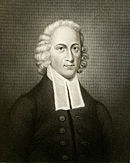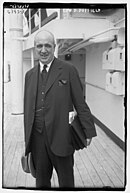
Princeton University is a private Ivy League research university in Princeton, New Jersey. Founded in 1746 in Elizabeth as the College of New Jersey, Princeton is the fourth-oldest institution of higher education in the United States and one of the nine colonial colleges chartered before the American Revolution. The institution moved to Newark in 1747, and then to its current campus, nine years later. It officially became a university in 1896 and was subsequently renamed Princeton University.

John Witherspoon was a Scottish-American Presbyterian minister, educator, farmer, slaveholder, and a Founding Father of the United States. Witherspoon embraced the concepts of Scottish common sense realism, and while president of the College of New Jersey became an influential figure in the development of the United States' national character. Politically active, Witherspoon was a delegate from New Jersey to the Second Continental Congress and a signatory to the July 4, 1776, Declaration of Independence. He was the only active clergyman and the only college president to sign the Declaration. Later, he signed the Articles of Confederation and supported ratification of the Constitution of the United States.

The president of Harvard University is the chief administrator of Harvard University and the ex officio president of the Harvard Corporation. Each is appointed by and is responsible to the other members of that body, who delegate to the president the day-to-day running of the university.

Hampden–Sydney College (H-SC) is a private liberal arts men's college in Hampden Sydney, Virginia. Founded in 1775, Hampden–Sydney is the oldest privately chartered college in the Southern United States, the tenth-oldest college in the US, the last college founded before the American Declaration of Independence, and the oldest of only three four-year, all-male liberal arts colleges remaining in the United States. Hampden–Sydney College is listed on the National Register of Historic Places and the Virginia Landmarks Register. It is affiliated with the Presbyterian Church (USA).

Delta Phi (ΔΦ) is a fraternity founded in 1827 at Union College in Schenectady, New York consisting of ten active chapters along the East Coast of the United States. The fraternity also uses the names "St. Elmo," "St. Elmo Hall," or merely "Elmo" because of its relation to Erasmus of Formia with some chapters known almost exclusively by one of these names on their respective campuses. Delta Phi was, after the Kappa Alpha Society and Sigma Phi Society, the third and last member of the Union Triad.

The Daily Princetonian, originally known as The Princetonian and nicknamed the 'Prince', is the independent daily student newspaper of Princeton University. The newspaper is owned by The Daily Princetonian Publishing Co. and boasts a circulation of 2,000 in print and around 30,000 daily online hits as of 2021. Managed by approximately 200 undergraduate students, the newspaper covers a range of sections, including news, sports, and opinions.

Chi Phi (ΧΦ) is considered by some as the oldest American men's college social fraternity that was established as the result of the merger of three separate organizations that were each known as Chi Phi. The earliest of these organizations was formed at Princeton University in 1824. Today, Chi Phi has over 47,000 living alumni members from over 100 active and inactive chapters and un-chartered associate chapters. Currently Chi Phi has about 48 active chapters.

First College, the first of Princeton University's six residential colleges, was developed in the late 1950s when a group of students formed the Woodrow Wilson Lodge as an alternative to the eating clubs. The Woodrow Wilson Lodge members originally met and dined in Madison Hall, which is now part of John D. Rockefeller III College. Inspired by the ideas of Woodrow Wilson, president of Princeton from 1902–1910, the members advocated a more thorough integration of academic, social and residential life on campus.

Samuel Finley was an Irish-born American Presbyterian minister and academic. He founded the West Nottingham Academy and was the fifth president and an original trustee of the College of New Jersey from 1761 until 1766.
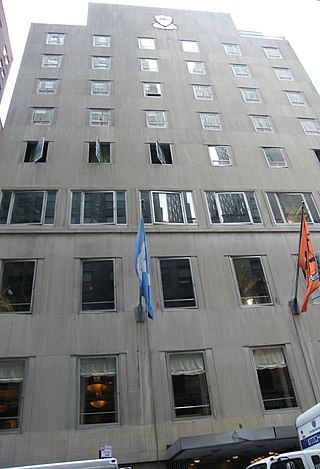
The Princeton Club of New York was a private clubhouse located at 15 West 43rd Street in Midtown Manhattan, New York City, New York, founded in 1866 as the Princeton Alumni Association of New York. It reorganized to its current name in 1886. Its membership was composed of alumni and faculty of Princeton University, as well as 15 other affiliated schools.
The Trustees of Princeton University is a 40-member board responsible for managing Princeton University's $37.6 Billion endowment (2021), real estate, instructional programs, and admission. The Trustees include at least 13 members elected by alumni classes, and the Governor of New Jersey and the President of the university as ex officio members.
Princeton University was founded in Elizabeth, New Jersey, in 1746 as the College of New Jersey, shortly before moving into the newly built Nassau Hall in Princeton. In 1783, for about four months Nassau Hall hosted the United States Congress, and many of the students went on to become leaders of the young republic.

John Maclean Jr., D.D. was an American Presbyterian clergyman and educator who served as the tenth President of Princeton University, then known as the College of New Jersey. Maclean, the son of the first professor of chemistry at the College of New Jersey, grew up in Princeton, New Jersey. He attended the College and later Princeton Theological Seminary. At age 23, he became full professor of mathematics at the university. Six years later, he became university vice president. He was responsible for bringing a number of renown scholars and academics to the college. During this time, he also left mathematics and became professor of ancient languages. Maclean was one of the chief architects of the state's public education system. His plan for a state normal school, local boards of education and nonsectarian public schools was adopted by the state legislature. He became president of the College of New Jersey in 1854. He led the university through the 1855 burning of Nassau Hall and the American Civil War. After retiring from his post after 14 years in office, he wrote a two-volume history of the university. He served as the honorary president of the university's Alumni Association until his death.

William Francis Magie (1858–1943) was an American physicist, a founder of the American Physical Society and the first professor of physics at Princeton University, where he had graduated and where he served for two decades as dean of the faculty. His papers on the contact angle of liquids and solids and on the specific heat of solutions were notable, as was his text Principles of Physics.
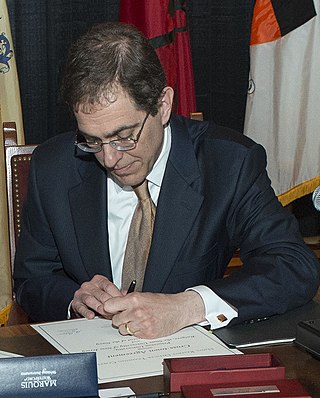
Christopher Ludwig Eisgruber is an American academic and legal scholar who is serving as the 20th President of Princeton University, where he is also the Laurance S. Rockefeller Professor of Public Affairs in the Princeton School of Public and International Affairs and the University Center for Human Values. He is also an expert on constitutional law, with an emphasis on law & religion and federal judicial appointments.
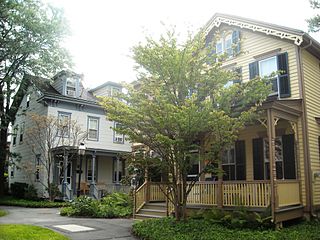
The Princeton Historic District is a 370-acre (150 ha) historic district located in Princeton, New Jersey that was listed on the U.S. National Register of Historic Places in 1975. It stretches from Marquand Park in the west to the Eating Clubs in the East, from the Princeton Cemetery in the north to the Graduate College in the south. The district encompasses the core parts of the campuses of the Princeton Theological Seminary and Princeton University. It also includes the business district centered on Nassau Street and many historic homes, both mansions in the western section and more humble dwellings in the Witherspoon/Jackson neighborhood. Notable churches within the district include Nassau Presbyterian Church, Trinity Episcopal, Nassau Christian Center, and the Princeton University Chapel. The district is home to seven of Princeton's nine, and New Jersey's fifty-eight, National Historic Landmarks, the largest concentration of such sites in the state.

Geology Hall is a historic building on the Queens Campus of Rutgers University, in New Brunswick, New Jersey. It was built from April 1871 to June 1872 to house various science classes and the Rutgers Geology Museum. The museum was established in 1872 by George Hammell Cook, Rutgers' then professor of geology, with a collection of specimens whose assembly began in the 1830s under Cook's predecessor, Lewis Caleb Beck. As classes and offices moved out of the hall, the museum expanded until it occupied the entire hall by the mid-20th century. In 1973, the hall was added to the New Jersey and National Register of Historic Places (NRHP) with Old Queens, President's House, Van Nest Hall, Daniel S. Schanck Observatory, the Kirkpatrick Chapel, and Winants Hall as part of the Old Queens Campus historic district.
Jacob Green was a Presbyterian pastor and acting president of Princeton University. A resident of Hanover, Green was also the delegate for Morris County to the fourth assembly of the Provincial Congress of New Jersey in 1776 and served as chairman of the constitutional committee.
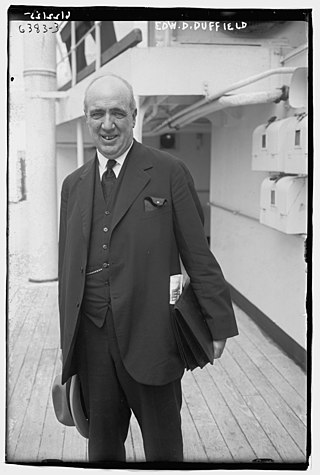
Edward Dickinson Duffield was an American politician, banker, and acting President of Princeton University following the retirement of John G. Hibben. Duffield served in the New Jersey Assembly from 1904 to 1905 and later became president of Prudential Insurance Company of America. He also acted as chairman of the board of trustees for Princeton University; he died from heart disease.

David Cowell (1704–1760) was a Presbyterian minister and briefly the acting president of Princeton University. A graduate of Harvard in 1732, Cowell was a trustee of the college. He was the acting president from 1757 to 1758 and also oversaw the negotiations that led to Samuel Davies becoming the fourth president of the college. He was the first pastor of the First Presbyterian Church in Trenton, New Jersey, serving from 1736 to 1760. He died in 1760 and was buried in the churchyard of First Presbyterian Church.




